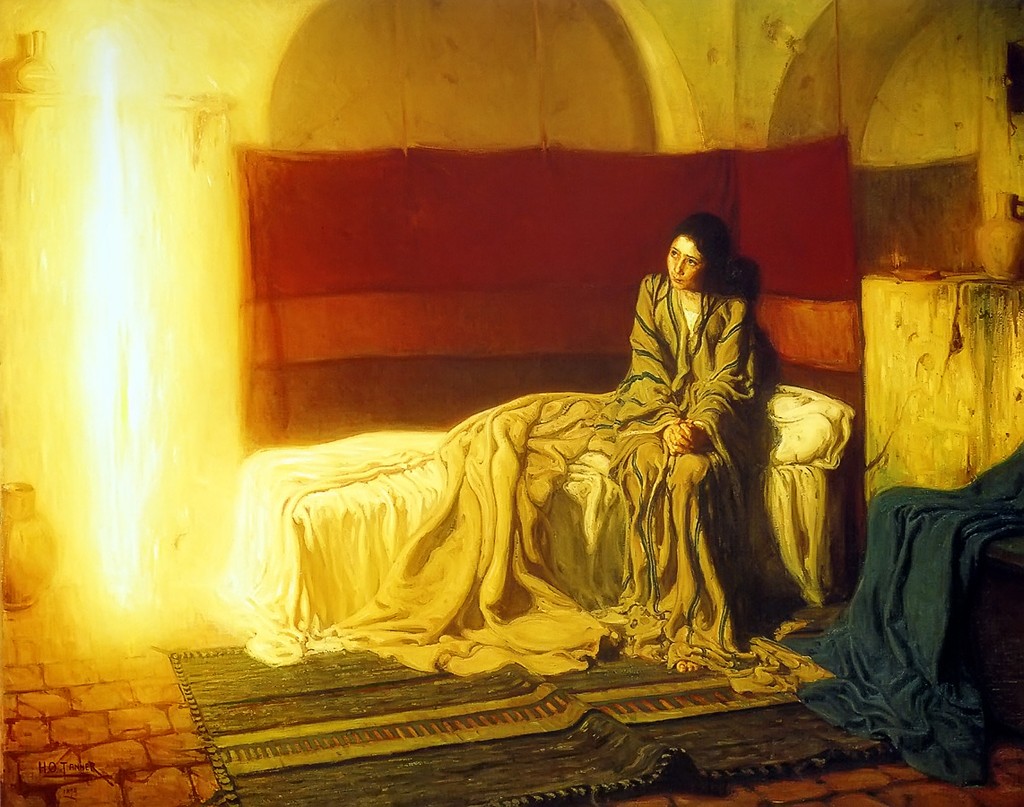Today is the feast of the Annunciation. The Gospel story of an encounter between an angel and a peasant girl in ancient Judea has provided us with a treasury of luminous depictions. Much as I love the inventory of them as works of art, only one draws me to wonder and to prayer. The essential commitments of faith do not begin in intellectual assent. That comes later. Intellect ratifies what the heart has already glimpsed. And the eye grasps certain things in an instant; the mind takes longer to grant approval to reasoned argument.
On this particular day my mind’s eye turns to a painting—a single, relatively modern one. Among the Western world’s long history of images of the Annunciation, none delights and convinces me more than Henry Ossawa Tanner’s The Annunciation (1898).

Tanner’s Annunciation is an ingenious blend of academic realism and abstract invention. No winged angel appears, no benedictory gesture. Feathered messengers are an ancient technology. But angels as we are used to imagining them are a pictorial device. The credibility of visual symbols can shift and retract. That winged one was weakening when Tanner painted in Paris in 1898. Like many ambitious Americans at the time, he had moved to Paris to study and to exhibit in the Salon. Within a decade, he became the premier biblical painter of his day. This, a mere five years before the airborne miracle of Kitty Hawk. The age of aviation was already in progress. It had begun in France a century earlier with the hot air balloon, designed and manned by inventive Frenchmen in 1783. By 1898 and in Paris—launching site of the first manned balloon flight—a winged courier suggested pigeon-post more than a vehicle for divine address.

Tanner, born in Pittsburgh, was the son of a bishop in the African Methodist Episcopal Church, the first independent black denomination in the United States. His religious upbringing set him askance of stereotypical imagery. In Tanner’s Annunciation, the God-bearing word travels, as ever, at the speed of light. Gabriel arrives as an electromagnetic pulse, a shimmering Doppler effect that proclaims a wonder in heaven and another within the soul of a girl.
And the girl! Gone is the Lady of medieval imagining, interrupted at her psalter. Here is a dark-haired, adolescent peasant from the hills of Galilee, one who never held a book. Teenaged Miriam, hands in her lap, looks into the light, weighing the message. She does not shrink back in awe (as in the Sienese version below). She makes no gesture of excessive humility. Her body language is attentive, poised. Composure in the face of the miraculous hints at something in the very nature of revelation. Gabriel’s extraordinary message bursts into the mundane. Domesticity is no bar to epiphany.

Look again at the Tanner. Notice that single, sturdy bare foot peeking out from a cascade of drapery. It is a small touch but one that marks Tanner’s intentional distance from centuries of Marian typology. In Western art, the Virgin might have bared one breast to suckle her baby but she was rarely, if ever, depicted barefoot. As if she never really touched the floor. But those traditional images of Mary nursing had a doctrinal purpose: to affirm the humanity of Jesus. With this simple glance at her toes, Tanner emphasizes the humanity of Mary. No need for the exaggerated modesty of a shod foot.
The Lust For Certitude
Fr. Charles Davis was the foremost theologian in the English-speaking world when he announced his decision to leave the Roman Catholic Church in 1966. His Temptations of Religion (1973) holds so many passages of true insight and deep religious feeling that his eventual return to communion (under the aegis of the Dominican order in Cambridge and Edinburgh) ought to have been no surprise. On this feast of the Annunciation one chapter in that book comes to mind: “The Lust for Certitude.” Davis viewed the quest for absolute certitude—uninflected by ambiguity or hesitancy before the inadequacies of language—as self-defeating:
[Faith] is a self-transcending, trustful love of God. . . . Religious faith in general is not designed for the insecure.
The certitude proper to faith comes unsought and only unsought. The reason is that the basic certitude in faith belongs to it, not as an intellectual assent, but as a self-transcending relationship with God or Ultimate Reality, a relationship analogous to love. . . . The basic assurance of not being deceived in a situation of love is grounded upon the experienced reality of the loving relationship, not upon explicit argumentation. The certitude is reached, not by directly seeking it, but as a consequence of the loving relationship as a lived fact. It is the same with faith. Its basic certitude cannot be directly achieved by appeal to reason or authority; it comes from living out the self-transcending relationship with God which constitutes faith.
That chapter closes with this: “Only when a person no longer seeks his own reassurance, but accepts the risk of loving another, will he gain the assurance he otherwise vainly seeks.” That seems, somehow, appropriate to the response of a pious Jewish girl to unsettling tidings from the hidden and living God.


